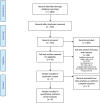Mobile telephone-delivered contingency management interventions promoting behaviour change in individuals with substance use disorders: a meta-analysis
- PMID: 31265747
- PMCID: PMC6852192
- DOI: 10.1111/add.14725
Mobile telephone-delivered contingency management interventions promoting behaviour change in individuals with substance use disorders: a meta-analysis
Abstract
Background/aims: Contingency management (CM) interventions have gained considerable interest due to their success in the treatment of addiction. However, their implementation can be resource-intensive for clinical staff. Mobile telephone-based systems might offer a low-cost alternative. This approach could facilitate remote monitoring of behaviour and delivery of the reinforcer and minimize issues of staffing and resources. This systematic review and meta-analysis assessed the evidence for the effectiveness of mobile telephone-delivered CM interventions to promote abstinence (from drugs, alcohol and tobacco), medication adherence and treatment engagement among individuals with substance use disorders.
Design: A systematic search of databases (PsychINFO, CINAHL, MEDLINE PubMed, CENTRAL, Embase) for randomized controlled trials and within-subject design studies (1995-2019). The review was conducted in accordance with the PRISMA statement. The protocol was registered on PROSPERO.
Setting: All included studies originated in the United states.
Participants: Seven studies were found, including 222 participants; two targeted alcohol abstinence among frequent drinkers and four targeted smoking cessation (in homeless veterans and those with post-traumatic stress disorder). One targeted medication adherence.
Measures: The efficacy of CM to increase alcohol and nicotine abstinence was compared with control using several outcomes; percentage of negative samples (PNS), quit rate (QR) and longest duration abstinent (LDA) at the end of the intervention.
Findings: The random-effects meta-analyses produced pooled effect sizes of; PNS [d = 0.94, 95% confidence interval (CI) = 0.63-1.25], LDA (d = 1.08, 95% CI = 0.69-1.46) and QR (d = 0.46, 95% CI = 0.27-0.66), demonstrating better outcomes across the CM conditions. Most of the studies were rated as of moderate quality. 'Fail-safe N' computations for PNS indicated that 50 studies would be needed to produce a non-significant overall effect size. None could be calculated for QR and LDA due to insufficient number of studies.
Conclusion: Mobile telephone-delivered contingency management performs significantly better than control conditions in reducing tobacco and alcohol use among adults not in treatment for substance use disorders.
Keywords: Contingency management; drug use; financial incentives; mobile telephone; remote monitoring; substance use.
© 2019 The Authors. Addiction published by John Wiley & Sons Ltd on behalf of Society for the Study of Addiction.
Figures




Similar articles
-
Mobile telephone-delivered Contingency Management (mCM) to reduce heroin use in individuals with opioid use disorder (CM4OUD): A feasibility study protocol.PLoS One. 2025 May 28;20(5):e0324516. doi: 10.1371/journal.pone.0324516. eCollection 2025. PLoS One. 2025. PMID: 40434969 Free PMC article.
-
Interventions to increase adherence to medications for tobacco dependence.Cochrane Database Syst Rev. 2019 Aug 16;8(8):CD009164. doi: 10.1002/14651858.CD009164.pub3. Cochrane Database Syst Rev. 2019. PMID: 31425618 Free PMC article.
-
Interventions to reduce tobacco use in people experiencing homelessness.Cochrane Database Syst Rev. 2020 Dec 3;12(12):CD013413. doi: 10.1002/14651858.CD013413.pub2. Cochrane Database Syst Rev. 2020. PMID: 33284989 Free PMC article.
-
Folic acid supplementation and malaria susceptibility and severity among people taking antifolate antimalarial drugs in endemic areas.Cochrane Database Syst Rev. 2022 Feb 1;2(2022):CD014217. doi: 10.1002/14651858.CD014217. Cochrane Database Syst Rev. 2022. PMID: 36321557 Free PMC article.
-
Mobile phone-based interventions for improving adherence to medication prescribed for the primary prevention of cardiovascular disease in adults.Cochrane Database Syst Rev. 2021 Mar 26;3(3):CD012675. doi: 10.1002/14651858.CD012675.pub3. Cochrane Database Syst Rev. 2021. PMID: 33769555 Free PMC article.
Cited by
-
New Directions for Motivational Incentive Interventions for Smoking Cessation.Front Digit Health. 2022 Feb 28;4:803301. doi: 10.3389/fdgth.2022.803301. eCollection 2022. Front Digit Health. 2022. PMID: 35310552 Free PMC article.
-
Could COVID expand the future of addiction research? Long-term implications in the pandemic era.Addiction. 2022 Aug;117(8):2135-2140. doi: 10.1111/add.15790. Epub 2022 Jan 25. Addiction. 2022. PMID: 35038780 Free PMC article.
-
How Individuals Seeking Help for Substance Use Disorder Adjusted to Virtual 12-Step Meetings During the COVID-19 Pandemic.Inquiry. 2025 Jan-Dec;62:469580251320767. doi: 10.1177/00469580251320767. Inquiry. 2025. PMID: 40017449 Free PMC article.
-
Practical Technology for Expanding and Improving Substance Use Disorder Treatment: Telehealth, Remote Monitoring, and Digital Health Interventions.Psychiatr Clin North Am. 2022 Sep;45(3):515-528. doi: 10.1016/j.psc.2022.05.006. Epub 2022 Jul 31. Psychiatr Clin North Am. 2022. PMID: 36055736 Free PMC article. Review.
-
A Scoping Review of Opioid Use Disorder Treatment Barriers and Telehealth for African Americans with Disabilities in Rural Communities.J Rehabil. 2022;88(1):74-87. J Rehabil. 2022. PMID: 38528879 Free PMC article.
References
-
- Prendergast M., Podus D., Finney J., Greenwell L., Roll J. Contingency management for treatment of substance use disorders: a meta‐analysis. Addiction 2006; 101: 1546–1560. - PubMed
-
- Lussier J. P., Heil S. H., Mongeon J. A., Badger G. J., Higgins S. T. A meta‐analysis of voucher‐based reinforcement therapy for substance use disorders. Addiction 2006; 101: 192–203. - PubMed
-
- Griffith J. D., Rowan‐Szal G. A., Roark R. R., Simpson D. D. Contingency management in outpatient methadone treatment: a meta‐analysis. Drug Alcohol Depend 2000; 58: 55–66. - PubMed
-
- Higgins S. T., Silverman K. Contingency Management in Substance Abuse Treatment. New York, NY: Guilford Press; 2008.

